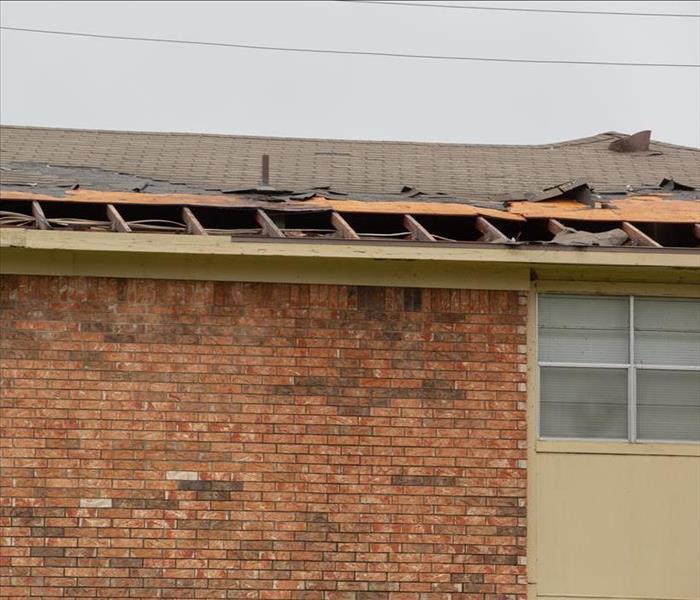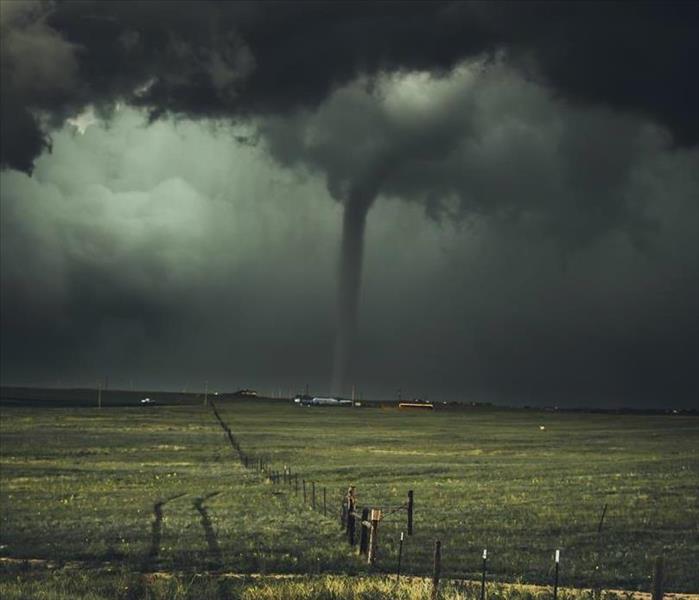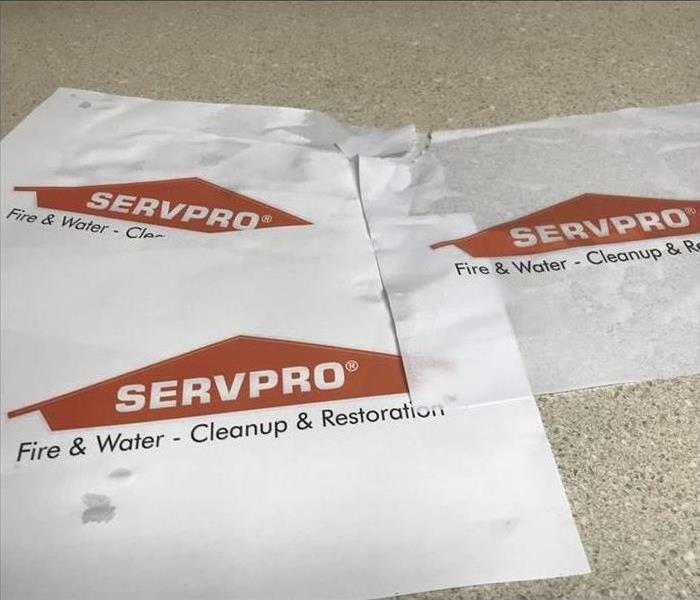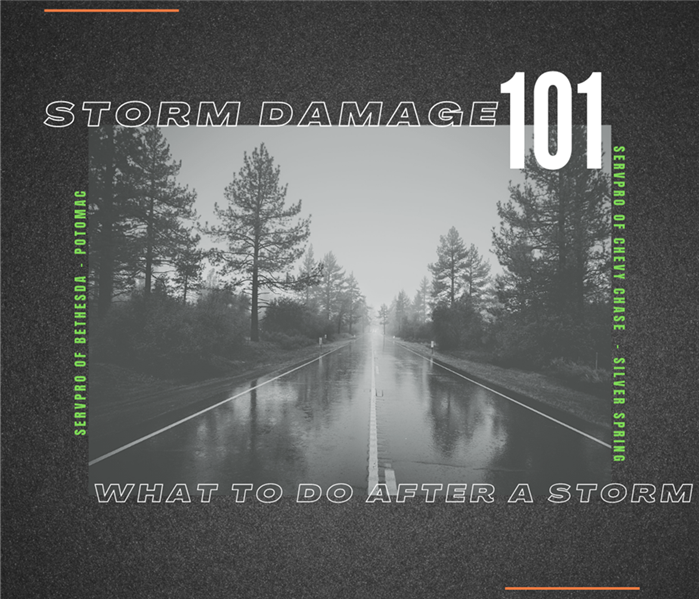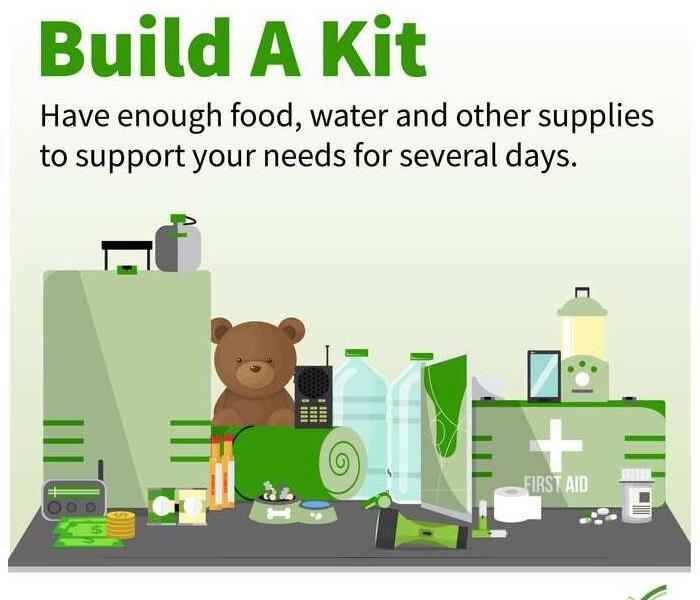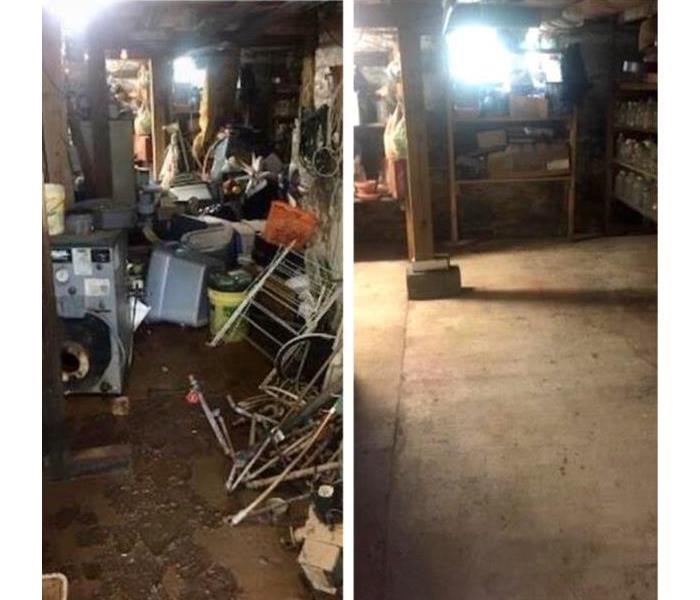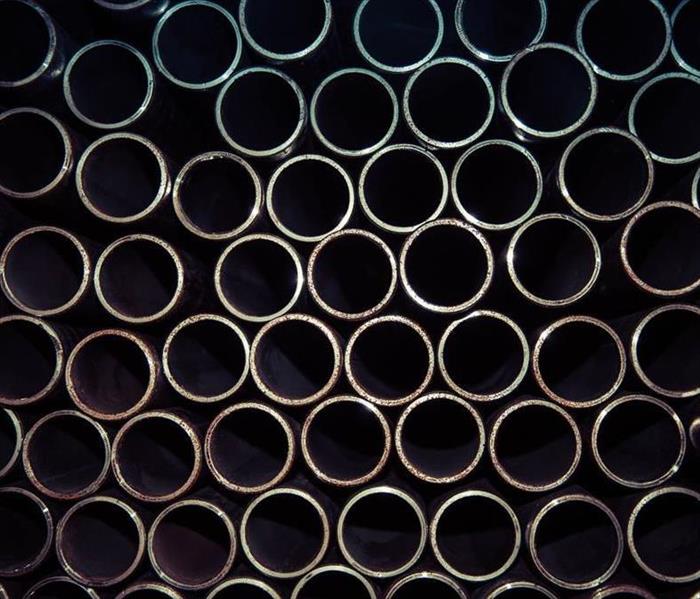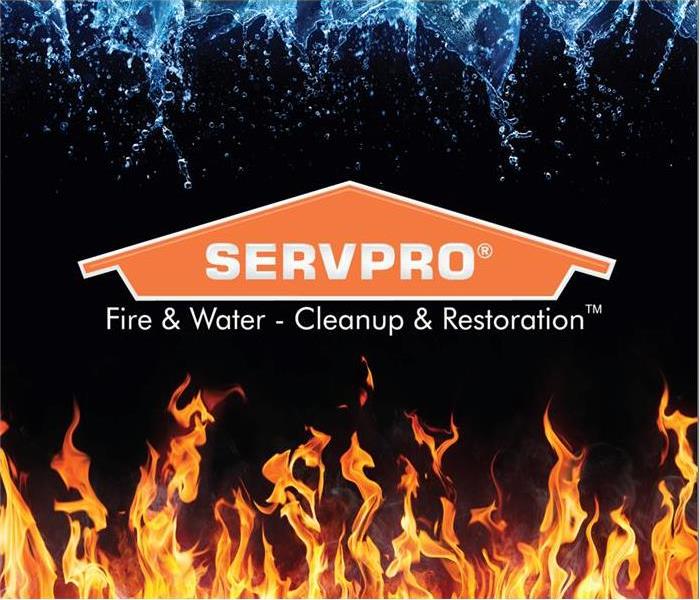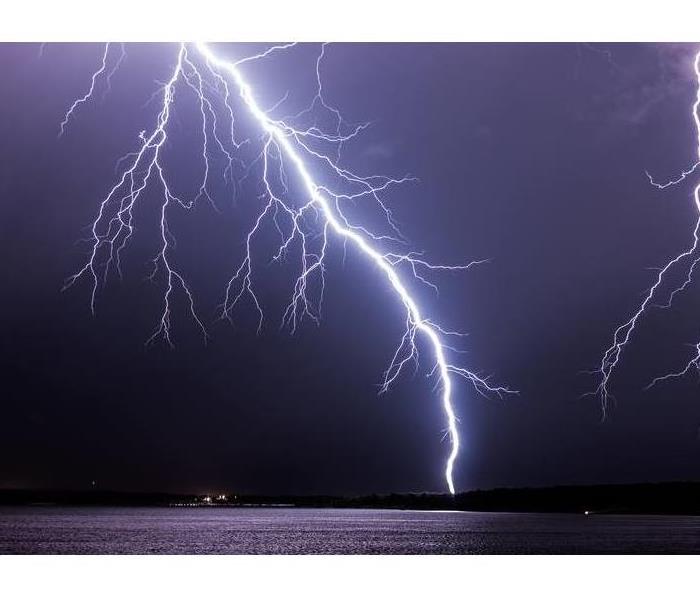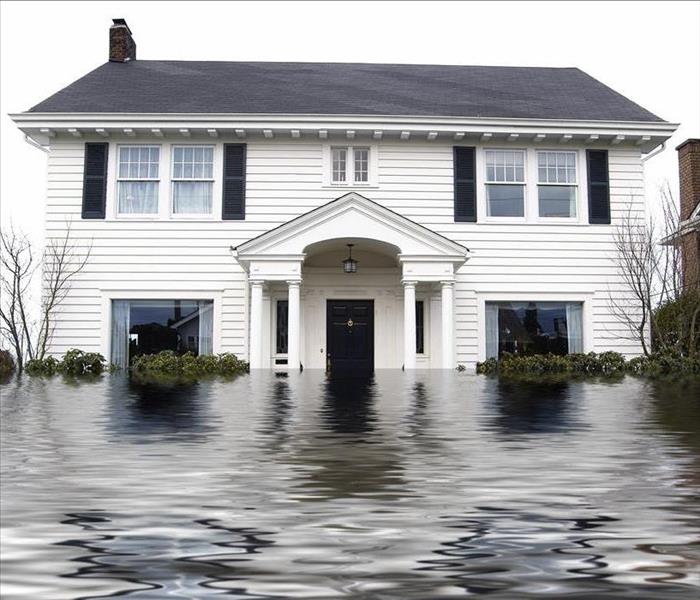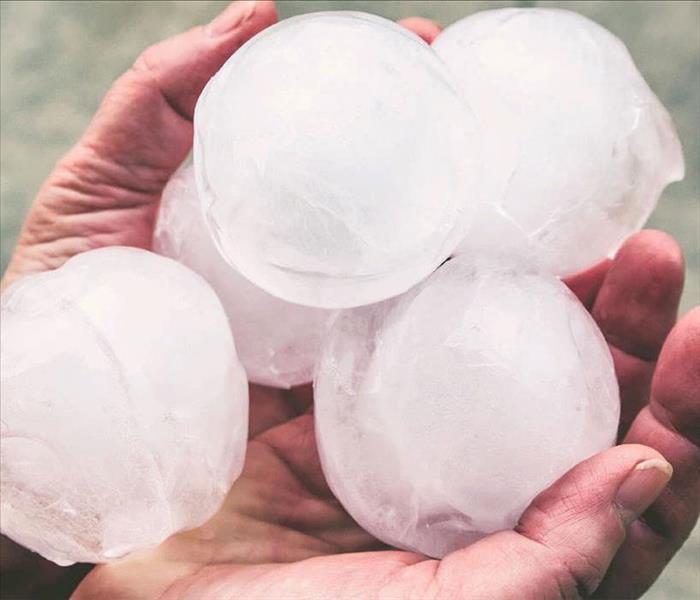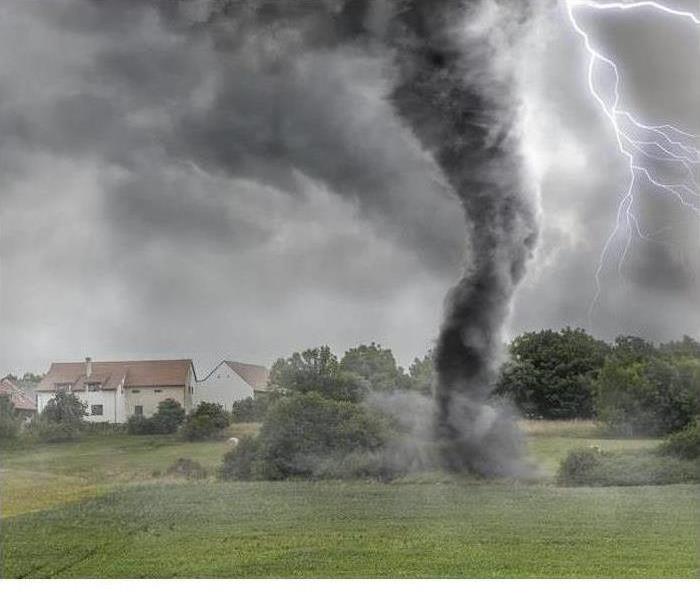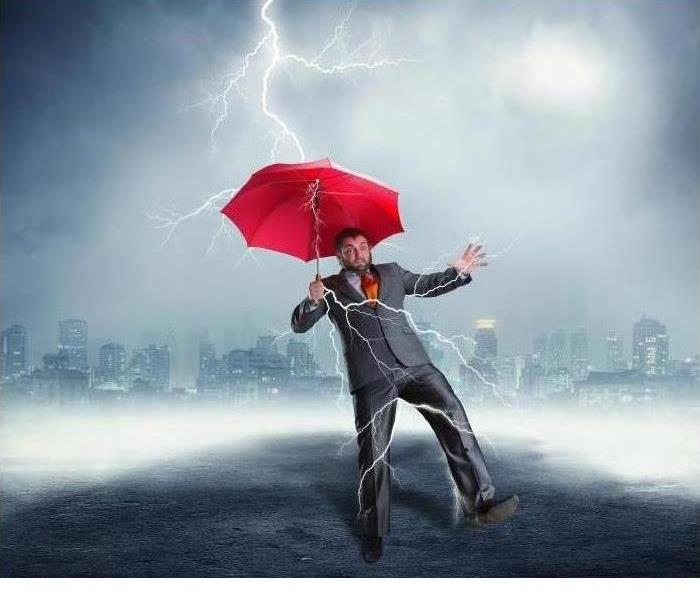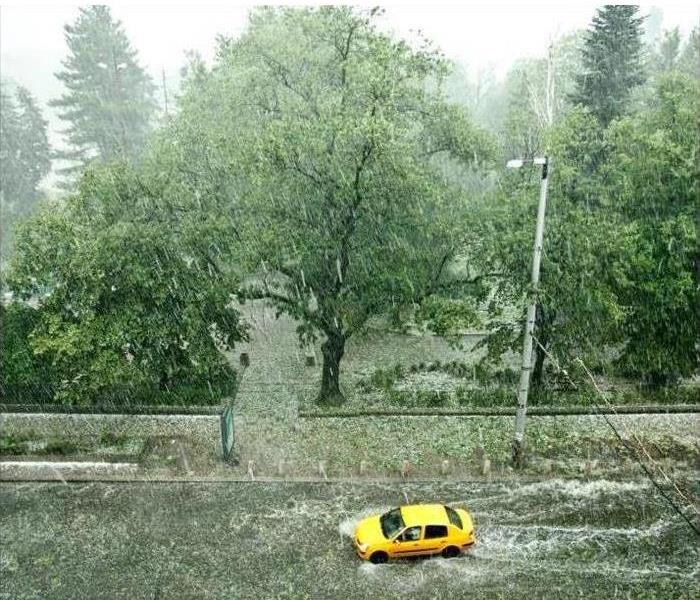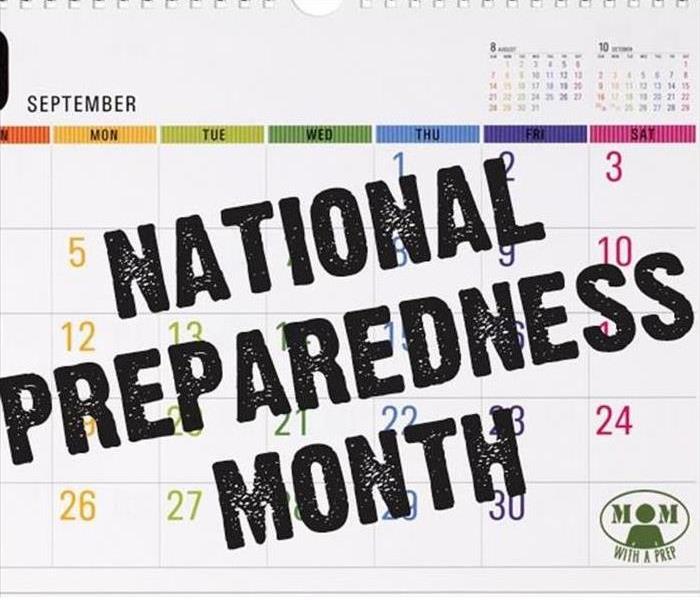Recent Storm Damage Posts
August Safety Blog: Lightning Safety Awareness
8/27/2024 (Permalink)
As we move through the summer months, storm season is still in full swing, and it's essential to remain vigilant when it comes to thunderstorm safety. At SERVPRO of Potomac, we know that lightning strikes pose a significant risk, and the National Weather Service has shared valuable tips to keep you safe.
The key takeaway is simple: “There is no safe place outside when thunderstorms are in the area.” If you hear thunder, you are close enough to be in danger of a lightning strike. The best way to protect yourself is by avoiding outdoor activities during thunderstorms and following the golden rule: "When Thunder Roars, Go Indoors!"
Unfortunately, many lightning-related injuries and deaths occur because people do not react quickly enough. Waiting too long to seek shelter puts you at unnecessary risk. Here's what you need to know to stay safe:
Tips for Staying Safe During Thunderstorms
Have a Lightning Safety Plan: Always be prepared. If thunderstorms are forecasted, cancel or postpone outdoor activities, and keep an eye on weather updates.
Get to a Safe Place: As soon as thunder is heard or the sky looks threatening, head indoors. Substantial buildings with walls and roofs, or hard-topped vehicles, are safe options. Avoid small shelters, sheds, or open vehicles like golf carts, as these do not provide adequate protection.
Avoid Electrical Appliances Indoors: Once indoors, do not touch anything connected to electricity, including plugged-in appliances, corded phones, or plumbing. Cell phones and cordless phones are safe to use. Keep a distance from windows and doors.
Understanding Lightning Risk Behavior
The risk of being struck by lightning increases as a thunderstorm approaches, reaches a peak when the storm is overhead, and decreases as it moves away. However, human behavior plays a crucial role in preventing lightning strikes. To minimize the risk:
Seek shelter early: Don't wait for the storm to be directly overhead.
Stay inside longer: Once indoors, remain sheltered for at least 30 minutes after the last sound of thunder or lightning strike.
Final Thoughts
By staying alert and following these safety guidelines, you can significantly reduce your chances of being struck by lightning. At SERVPRO of Potomac, we remind you that your behavior during a thunderstorm determines your risk level. When you hear thunder, seek shelter immediately.
When Thunder Roars, Go Indoors! Stay safe and protect yourself this storm season.
Be Prepared for Storms and Flooding
8/15/2023 (Permalink)
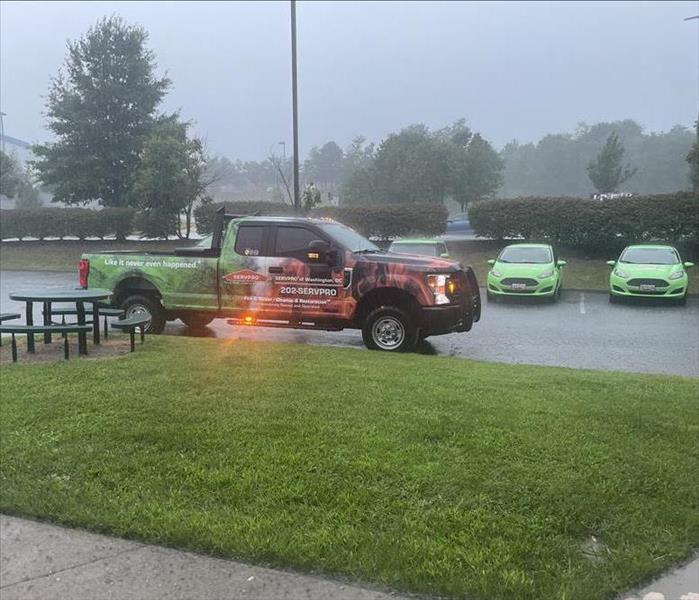 Storms and flooding can happen at any given moment. Be prepared!
Storms and flooding can happen at any given moment. Be prepared!
Storms and heavy flooding are a common natural disaster in the Bethesda/Potomac and Chevy Chase/Silver Spring area. We can experience a range of weather conditions, including heavy rainfall, snowmelt, and occasional hurricane or tropical storms, which can all contribute to flooding storms.
According to the American Red Cross, floods cause more damage in the U.S. every year than any other weather related disaster. When facing a flood, prioritizing safety is crucial.
Here’s what you need to know to stay safe during and after flooding:
- If you approach flooded roads while driving, turn around and go another way. Get out of the car quickly and move to higher ground.
- Stay away from floodwaters. If you are caught up on a flowing stream, and the water is above your ankles, stop, turn around and go another way.
- Keep children and pets out of the water.
- Stay updated on weather forecasts and flood warnings. Listen to local authorities and emergency services for instructions.
- If authorities recommend evacuation, follow their instructions promptly. Have an emergency kit ready with essentials.
- Inspect your property for structural damage before entering. Look for cracks, holes, and other signs of instability.
- If your property is flooded, avoid turning electricity until it’s deemed safe by an expert.
When flooding strikes your home or business, contact SERVPRO of Bethesda/Potomac and Chevy Chase/Silver Spring professionals. Even minor floods have the potential to cause major damage to a structure when not treated quickly and properly, and the cleanup is often an overwhelming task. SERVPRO is prepared to handle any sized disaster. Call us 24/7 at 301-530-7400. We are Here to Help!
Storm Safety Tips - National Preparedness Month
9/8/2022 (Permalink)
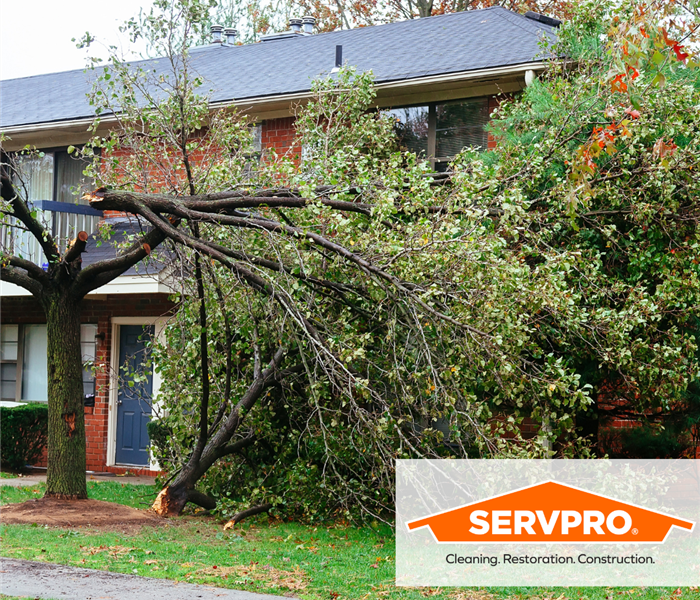 National Preparedness Month - Storm Ready
National Preparedness Month - Storm Ready
Storms can strike anywhere and at any time. According to the NOAA, weather incidents could result in nearly $15 billion in damages.
Think about how different disasters could affect your Bethesda, Potomac, Chevy Chase, and Silver Spring property. Take the necessary steps to become informed and develop an emergency plan for before, during, and after an event for your family and pets. Read more to learn about basic emergency supply kit items you should have.
Basic Emergency Supply Kit
- First aid kit
- Water and non-perishable food for several days
- Flashlight and extra batteries
- First aid kit
- Prescription medication and glasses
- Cash
- Can opener (Optional, if your kit contains canned foods)
We Are Here To Help
SERVPRO of Bethesda, Potomac and SERVPRO of Chevy Chase/Silver Spring hope that with a little planning, you can help us approach disasters in a calm manner. A clear plan can reduce fear and anxiety during evacuation so that the process will not become chaotic and messy. Panic tends to exacerbate disaster outcomes, so always remember to keep yourself as collected as possible.
Emergency Ready Plan
If your company requires assistance developing an emergency plan, let SERVPRO of Bethesda, Potomac and SERVPRO of Chevy Chase/Silver Spring do it for you. We specialize in Emergency Ready Profiles, which help mitigate disruption and business interruption in the event of an emergency.
Learn More About Emergency Ready Profiles >
CALL US
(301) 530-7400
When a Storm Strikes, SERVPRO of Bethesda/Potomac and SERVPRO of Chevy Chase/Silver Spring Are Here for You
5/31/2022 (Permalink)
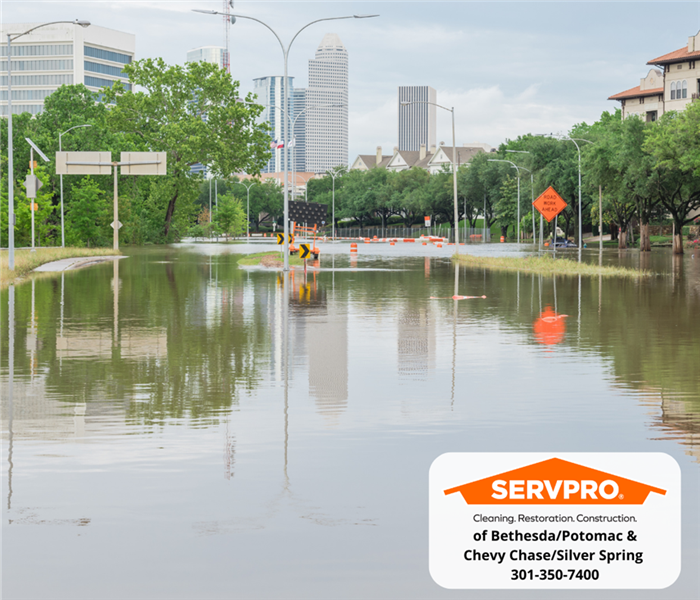 Be prepared for unexpected storms that can damage property.
Be prepared for unexpected storms that can damage property.
Planning is the best thing you can do to mitigate storm damage. A recovery plan will help you act immediately and prevent further damage from occurring. Read more to learn about the benefits of choosing SERVPRO of Bethesda/Potomac and SERVPRO of Chevy Chase/Silver Spring as your restoration company.
We Are One Call Away
Storm damage can cause both structural damage and water damage. Whether you have minor storm damage or something larger to deal with, our certified technicians have the experience & equipment needed to clean up and restore your home, business, or commercial building and help get your life back to normal following storm damage.
Highly trained Certified Professionals
Our certified professionals specialize in residential & commercial water damage restoration, with training focused on restoring salvageable items and accelerating drying time while documenting the entire restoration process. We adhere to the Institute of Inspection Cleaning and Restoration Certification (IICRC) industry guidelines, and we offer classes and online learning tools to provide our customers with the utmost customer service experience.
Available 24/7
SERVPRO of Bethesda/Potomac and SERVPRO of Chevy Chase/Silver Spring is locally owned and operated. Our customer service representatives are ready to take your call, day or night. We have a network of strategically positioned storm teams on standby should a disaster strike near your Montgomery County property. Our water mitigation teams are available 24 hours a day, 365 days a year.
Trust SERVPRO of Bethesda/Potomac and SERVPRO of Chevy Chase/Silver Spring
We have more than 45+ years of experience in repair and restoration, so you can trust us to help you develop a storm damage restoration plan to help ensure your home, business, or commercial building is dry, clean, and restored to its pre-existing state. Therefore, we will do everything to work with you and complete your restoration without hassle.
If you have experienced storm damage or want to learn more about our services, call us at 301-530-7400
Be Prepared in Case of a Thunderstorm in Montgomery County
4/27/2022 (Permalink)
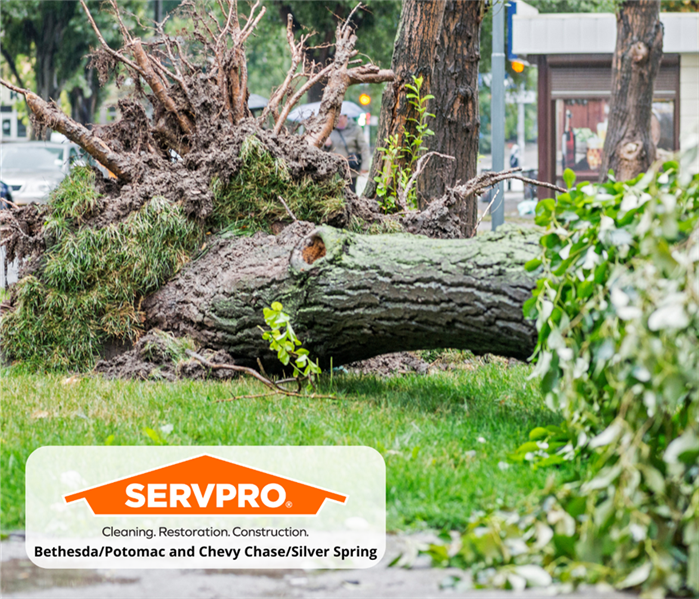 SERVPRO of Bethesda/Potomac & SERVPRO of Chevy Chase/Silver Spring is always Here to Help!
SERVPRO of Bethesda/Potomac & SERVPRO of Chevy Chase/Silver Spring is always Here to Help!
April showers do not always bring May flowers. Residential and commercial property owners cannot always prepare for severe weather. Severe weather can include hazardous conditions produced by thunderstorms, including damaging winds, tornadoes, large hail, and flash flooding. Storms can be incredibly dangerous, and it is important to put your family and pet safety first.
Protecting Your Home from Thunderstorms & Lightning
Pay attention to the weather forecasts for information on thunderstorms in the Bethesda, Potomac, Chevy Chase, and Silver Spring areas. Protect your home before a thunderstorm by cutting down or trimming trees that may fall on your home during a storm. Also, consider buying surge protectors, lightning rods, or a lightning protection system to protect your electronic devices, appliances, and home. In addition, make sure that your sump pump is working properly.
Prepare Your Family and Pets for Thunderstorms
- Discuss thunderstorm safety and lightning safety with all members of your household.
- Identify a safe space in your home for household members, including pets to gather during a thunderstorm.
- Put together an emergency preparedness kit.
- Pay attention to alerts and warnings.
- Unplug appliances.
- Avoid flooded roads, six inches of moving water can knock you down, and one foot of water is not safe for vehicles.
SERVPRO of Bethesda/Potomac and SERVPRO of Chevy Chase/Silver Spring can respond immediately to storm and water damage. Our certified technicians are ready to restore your home, business, or commercial property quickly. Your home may need construction work, and we can simplify the restoration process by handling the initial damage mitigation and rebuilding the affected areas. You should choose the company with the most storm damage experience and the best understanding of treatment. To learn more about SERVPRO of Bethesda/Potomac and SERVPRO of Chevy Chase/Silver Spring storm resources click here.
SERVPRO of Bethesda/Potomac and SERVPRO of Chevy Chase/Silver Spring is always Here to Help! Call us at (301) 530-7400 or (301) 588-2240.
Storm Safety Spring Thunderstorms
3/14/2022 (Permalink)
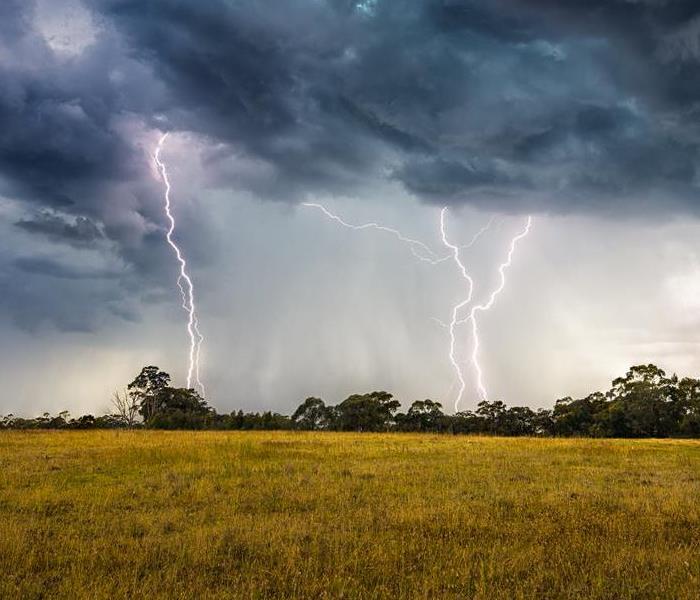 SERVPRO of Bethesda/Potomac & SERVPRO of Chevy Chase/Silver Spring provide Storm Damage Restoration Services
SERVPRO of Bethesda/Potomac & SERVPRO of Chevy Chase/Silver Spring provide Storm Damage Restoration Services
Spring is finally here, and we are starting to experience warmer temperatures. A common spring weather hazard is a thunderstorm. Thunderstorms can produce a combination of large hail, damaging winds, and flash floods. Keep reading to learn more about thunderstorms and how they can impact your home, business, or commercial building.
Signs of Approaching Thunderstorms:
- Increasing winds
- Sound of thunder
- Flashing of lightning
When are thunderstorms likely to happen?
Thunderstorms are not uncommon in the Bethesda, Potomac, Chevy Chase, and Silver Spring regions. Thunderstorms are most likely to occur during the spring and summer months. According to the National Severe Storms Laboratory, thunderstorms can occur year-round and are more likely to occur during the afternoon and evening hours.
Thunderstorm Safety Tips for Your Home
During a thunderstorm, homes or businesses are subjected to flash flooding, lightning strikes, and large hail. To stay safe during a thunderstorm event, get to shelter, have a plan, and stay indoors. The following are safety tips to strengthen your home or business:
- To protect your home, appliances, and electronic devices consider buying surge protectors, lightning rods, or a lightning protection system.
- Cut down or trim down trees that may fall on your home.
- Install a backup generator.
- Close all windows, doors, and garage doors when lighting is in the area.
SERVPRO Storm Damage Team
Regardless of the weather season, SERVPRO of Bethesda/Potomac and SERVPRO of Chevy Chase/Silver Spring provide Storm Damage Restoration services that will help return your home or business to its pre-existing state. Team Hargrove has the experience and equipment to help with your clean-up, restoration, and construction needs. Our local office provides 24-hour Emergency Service call SERVPRO of Bethesda/Potomac and SERVPRO of Chevy Chase/Silver Spring at 301-530-7400 or 301-588-2240. Our certified technicians can help make it "Like it never even happened."
Storm Damage & Fast Remediation for Faster Results
2/23/2022 (Permalink)
Storm Damage in the Bethesda, Potomac, Chevy Chase, Silver Spring can affect both the exterior and interior of your home or business. When dealing with storms, floods, and water damage, immediate action is critical. SERVPRO of Bethesda/Potomac and SERVPRO of Chevy Chase/Silver Spring can respond immediately to water and storm damage emergencies. We handle all jobs of any size.
When storms approach our region, we usually have no time to prepare. Severe weather can cause damage to many homes in the Bethesda, Potomac, Chevy Chase, and Silver Spring area. Shingles, skylights, pipe collars, and roof vents damaged by a storm are no match for our certified technicians. We can provide a trap if necessary and repair damages to your home or business. Our certified technicians will repair the interior of your home and make it "Like it never even happened." Our technicians will remove most of the water. We use powerful pumps and vacuum units to quickly remove hundreds or thousands of gallons from your home or business. We can also provide you with content manipulation if any personal items or furniture are in the areas affected. Our certified technicians can also repair any structural materials to the pre-existing state.
SERVPRO Water Cleanup & Restoration
SERVPRO certified technicians provide build-back services and temporary measures to address storm damages:
- Roof tarping
- Board-ups
- Temporary framing
- Plywood
- Contents manipulation
Following these measures prevent further damages and allows technicians to continue their work even when power outages occur. Our certified technicians have the experience and the knowledge to help you remediate and restore your home.
Locally Owned Company in the DMV
Calling SERVPRO of Bethesda/Potomac and SERVPRO of Chevy Chase/Silver Spring at 301-530-7400 or 301-588-2240 can help lessen the damage, limit further damage, and reduce cost. We are always Here to Help, 24/7. We can provide you with a preliminary estimate and with a plan. We service the Montgomery County, Prince George’s County, and Washington, DC region. Our certifications are from the IICRC and cover installations, repairs, cleaning, and restorations.
When a Storm Hits Your Montgomery County Property, We Are One Call Away
12/13/2021 (Permalink)
After a storm hits our region, the difficult part is restoring your home to its original state. Hire restoration professionals to make it “Like it never even happened.” There are several types of storms that cause damage to one’s home or business. For example, types of storm damage include heavy rainstorms, flooding, wind damage, and snowstorms.
Our Certified Technicians Can Help After a Flood
Regardless of the type of damage your home experiences, you should assess your safety before recovering personal items. We understand that your home is important, but your safety is more important during a disaster. SERVPRO of Bethesda/Potomac and SERVPRO of Chevy Chase/Silver Spring has a 24-hour emergency dispatching service that can put you in direct contact with one of our professional, certified technicians. Our dispatcher can schedule you for an inspection with one of our project managers, and we can then provide you with a preliminary estimate.
The moment you see signs of storm damage, contact your certified experts to remediate the problem. Even if the scope of the damage appears minor. The longer it persists the more likely it is to cause further damage to your home or business. It is always better to be safe than sorry when it comes to the safety of your property.
Types of Secondary Damage
- The potential spread of bacterial or viral contamination is present in the flood water
- Dangerous mold infestations
- Further structural damage if moisture spreads from the impacted area
How does SERVPRO Stop and Fix Further Damage?
- Depending on the level of damage-controlled demolition may be required
- To keep moisture from spreading, technicians perform flood cuts six inches above the damage
- Air movers and dehumidifiers will be placed to dry the impacted area
- After the area is thoroughly dried and moisture content restored, technicians can replace the drywall
- Once the wall is rebuilt, we will repaint the drywall to make it “Like it never even happened.”
If your home or business needs storm remediation, you can trust your local SERVPRO of Bethesda/Potomac and SERVPRO of Chevy Chase/Silver Spring franchise to help you get your life back after a storm or flood disaster. For 24/7 emergency assistance, contact us at (301)-530-7400 or 301-588-2240. We’re Faster To Any Size Disaster.
Want to know more about your local SERVPRO.
Advantages of a Pack-out When a Flood Occurs in Your Montgomery County Home
10/25/2021 (Permalink)
SERVPRO is the #1 Leader in the restoration and cleanup industry
Flooding in your home is not the most favorable experience. Heavy rains cause serious damage and can cause water intrusion onto your property. If your home is affected by flooding, the structure of your home and your furnishing can be at severe risk. Montgomery County residents can improve their odds for a successful restoration by taking advantage of our pack-out and move-out services.
SERVPRO of Bethesda/Potomac and SERVPRO of Chevy Chase/Silver Spring can conduct an organized, efficient move-out of the affected area. A move-out will provide several benefits, including the following:
- A quicker remodeling process
- Protecting items from potential damage
- Protecting contents from further on-site damage
When the restoration process is completed, we will work with you to coordinate the move-in according to your needs. The services offered upon move-in may depend on your insurance coverage.
Pack-Out During Water Mitigation Restoration
When you have a disaster, one of the first things we do is send a team to sort and box your belongings. Our pack-out service is the process when we move out a customer’s contents to a secured location in our warehouse. We handle your items and furnishing with detail and care to avoid breakage and maintain a proper inventory of the contents. To ensure that everything is accounted for, we scan and catalog every item into our system before placing them in labeled boxes.
We Restore and Clean Your Belongings
Our certified technicians use a range of cleaning techniques and proprietary products to restore your belongings as close as we can to their original condition. At our warehouse, our facility is equipped with an ozone chamber to eliminate any lingering odors. Textiles we work with include clothes, linens, and stuffed animals.
Flash Floods In Montgomery County - What to do?
9/9/2021 (Permalink)
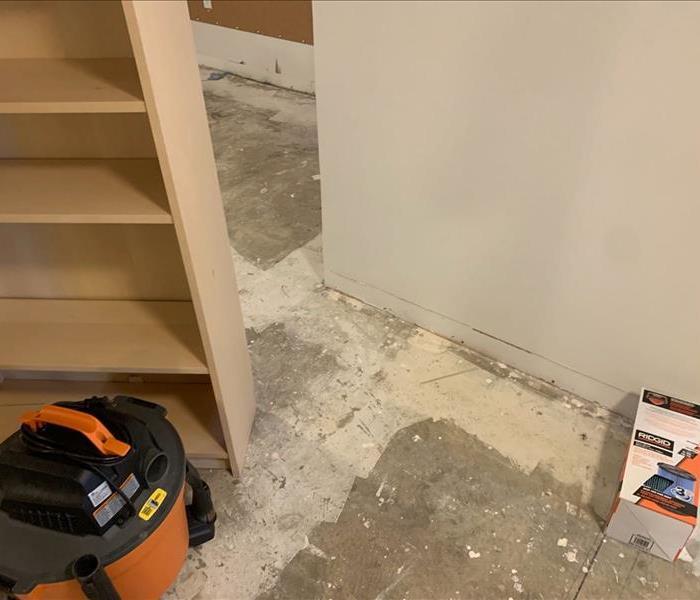 SERVPRO of Bethesda/Potomac and SERVPRO Chevy Chase/Silver Spring specializes in Fire and Smoke Restoration - contact us at 301-530-7400.
SERVPRO of Bethesda/Potomac and SERVPRO Chevy Chase/Silver Spring specializes in Fire and Smoke Restoration - contact us at 301-530-7400.
A few weeks ago, the Montgomery County area was hit by intense storms and flash flood warnings. Have you ever wondered if your home or business is safe in the event of a flash flood? You may believe that a flood will not affect your property, yet everyone is in a flood zone regardless of where they reside.
Tips for when storms and flash floods are in our area:
- Stay on high grounds! Stay away from low areas where water from a storm can accumulate.
- If you have to evacuate, remember to pack all of your essentials, including your insurance policy, your insurance company contact information, toiletries, and emergency fund.
- For emergency, information updates check your local news.
Preventative steps to take:
Install a rubber roof underlayment - if you are replacing your roof. A rubber roof underlayment is a great preventive step to have in the event of severe weather. A rubber roof underlayment installed can prevent leaks and water from coming inside your property.
Keep it clean - make sure your gutters and drains are cleaned out regularly. Remove all debris, including leaves, twigs, and branches, to keep them from clogging and overflowing into your property.
Keep a battery-powered sump pump - to pump water out of your property. In the event of a power outage, a sump pump running on electricity will not work. If you have a battery-powered sump pump, you will not run into that issue, ridding your home of excess water.
If your property is affected by a flood, you should contact our certified technicians at SERVPRO to restore the water damage. Do not let water damage take control of your daily routine. We are about our local communities, and we care about you. SERVPRO of Bethesda / Potomac and SERVPRO Chevy Chase / Silver Spring provide a quick and efficient response. If you have questions regarding fire or water restoration and what we do, call us SERVPRO of Bethesda / Potomac and SERVPRO of Chevy Chase / Silver Spring 301-530-7400.
If Pets Are Part Of The Family They Should Be Part Of The Plan
5/25/2021 (Permalink)
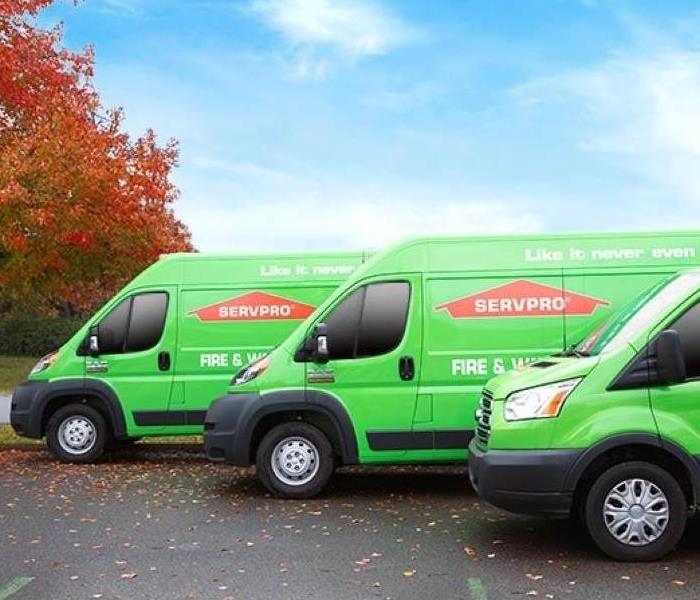 SERVPRO of Bethesda / Potomac and SERVPRO of Chevy Chase / Silver Spring 301-530-7400
SERVPRO of Bethesda / Potomac and SERVPRO of Chevy Chase / Silver Spring 301-530-7400
Planning For Severe Storms, SERVPRO of Bethesda / Potomac and SERVPRO of Chevy Chase / Silver Spring
If pets are a part of your family you take care of them each day. If you have a storm plan for your family, did you consider your pet? The Federal Emergency Management Agency (FEMA) suggests including your pet in storm planning to avoid issues when storms or hurricanes hit.
Make a Plan
If you have a plan in place for you and your pets, you will likely encounter less difficulty, stress and worry when you need to make a decision during an emergency.
THINGS TO INCLUDE IN YOUR PLAN:
¦ Know what to do with your pet during an evacuation . Many public shelters and hotels do not allow
pets inside. Know a safe place where you can take your pets before disasters and emergencies happen.
¦ Develop a buddy system. Plan with neighbors, friends or relatives to make sure that someone is
available to care for or evacuate your pets if you are unable to do so.
¦ Have copies of your pet’s vaccination record, and make sure your pet is microchipped. Keep your address and
phone number up-to-date and include an emergency contact outside of your immediate area.
¦ Keep contact information for your local emergency management office or animal control office and shelters on
hand in case you become separated from your pet.
Calling In Professional Help After The Storm
If you have storm damage like flooding or other water damage call the professionals, SERVPRO of Bethesda / Potomac and SERVPRO of Chevy Chase / Silver Spring 301-530-7400.
It's important to take care of water damage before it becomes a bigger problem, like mold. It’s estimated that more than 1 million types of mold exist, yet less than 10 percent have actually been named. This means mold is very common in both indoor and outdoor environments.
Since we are locally owned and operated, we are able to respond quicker with the right resources, which is extremely important. A fast response lessens the damage, limits further damage, and reduces the restoration cost.
Be Storm Smart, Be Storm Ready
3/11/2021 (Permalink)
Read time: 1 minute
Severe weather can happen at any moment, anywhere. Every year, Americans cope with the average of the following violent storms*:
- 10,000 severe thunderstorms
- 5,000 floods or flash floods
- 1,000 tornadoes
- 2 landfalling, deadly hurricanes
Approximately 98% of all presidentially declared disasters are weather-related, resulting in about 500 deaths each year and about $15 billion in damages. * Knowing the risk of extreme weather, taking action, and being an example are only a few actions you can take to be more prepared to save your life and help save the lives of others.
Know Your Risk.
The first step to being weather-ready is to consider the type of hazardous weather that can affect where you live and work, and how weather can affect you, your company, and your family. Check the weather forecast regularly, get NOAA Weather Radio, and read more about Wireless Emergency Alerts. Severe weather comes in several ways, and your shelter plan should cover all kinds of local hazards.
Take Action.
Take the next step in extreme weather preparedness by designing a communication plan for your home or company. Put together or buy an emergency kit. Keep confidential documents and valuables in a secure location.
Be an Example.
Once you've taken steps to plan for extreme weather, share your story with your colleagues and family, and friends on Facebook or Twitter. Your tale of preparedness will encourage others to do the same thing.
Facts provided by Weather.gov
Storm Warnings 101
3/11/2021 (Permalink)
Read Time: 1 minute, 6 seconds
Storm Alerts can pop up anywhere: TV, mobile phone warnings, radio, etc., but do we understand what these warnings mean? Know these meanings so that you are prepared for any storm:
Different Storm Warnings
Tornado Watch
Conditions are ripe for tornadoes in the watch region. Tornadoes associated with hurricanes and tropical storms are usually a major cause of death and injury.
Tornado Warning
Visually or on the radar, a tornado was detected. Usually, it was given for a county. If a tornado WARNING is released where you live, GET THE MIDDLE OF THE LOWEST FLOOR OF THE STRONG BUILDING IMMEDIATELY!!!
Severe Thunderstorm Watch
Conditions are ripe for severe thunderstorms in the watch region.
Severe Thunderstorm Warning
There is a severe thunderstorm in or on the way to the warned area. Treat this as a warning tornado!
Flash Flood Watch
Flash floods are likely to take place in the near future. Be alert to rising water and be prepared to evacuate to high ground.
Flash Flood Warning
Flash floods are occurring or expected to occur in the near future. If this happens, get to high ground immediately, and GET AWAY FROM VEHICLES... it only takes 18 inches of water to sweep a car or truck away!
High Wind Advisory
Windy conditions may be present in the advisory region. This usually results in unsafe driving conditions, especially in (but not limited to) large vehicles. Also, avoid sailing anywhere in the advisory area.
High Wind Warning
Windy conditions may be present in the advisory region. This usually results in unsafe driving conditions, especially in (but not limited to) large vehicles. Also, avoid sailing anywhere in the advisory area.
3 Tips To Protect Your Business From A Flood
3/5/2021 (Permalink)
Your company can be at risk if flooding occurs. Floodwaters will force their way into your building and cause damage to floors, walls, and inventory if they are strong enough. If you know a flood is on the way, there are a few things you can do to protect your business and limit the damage that a natural disaster like this might cause.
Make Backup Copies of Important Data
If you suspect your building would be damaged by a storm, data backup should be a top priority. If your computer system is destroyed by flooding, shipping documents, customer data, and inventory records can not be retrievable, so having several archives of this information will save you time and money in the aftermath of the flood. For real-time data retrieval, consider cloud storage.
Rent a Sump Pump
If you suspect your building would be damaged by a storm, data backup should be a top priority. If your computer system is destroyed by flooding, shipping documents, customer data, and inventory records can not be retrievable, so having several archives of this information will save you time and money in the aftermath of the flood. For real-time data retrieval, consider cloud storage.
Do Not Hesitate To Act
Flood damage can occur quickly, especially during flash floods. If you think anything like this is going to happen, immediately evacuate your business and make sure your customers and employees are safe. This form of a flood can be caused by heavy rainfall, so stay alert and keep an eye on the weather in your area for any watches or warnings. If you suspect a flood, turn off critical systems and attempt to close off doors and windows until the building has been evacuated.
You may be concerned about the best way to protect your company if flooding occurs. Knowing how to react and plan for a flood, on the other hand, will help you minimize the damage and give you peace of mind both before and after the disaster.
Prevent Catastrophic Damages To Your Business During A Flood
2/22/2021 (Permalink)
Flood damage can occur quicker than you ever expected. Depending on the floods' severity. it can cause flooring, wall, and inventory damage. However, if you know that a flood is imminent, there are ways to protect your business by minimizing the destruction a natural disaster can create.
Make Backup Copies of Important Data
If you believe your building could suffer from storm damage, it is crucial to back up your data. This includes shipping records, customer data, and any inventory records that may not be retrievable if your computer system is damaged by water. Having more than one copy of your data can save you a lot of time and money during the aftermath of a potential flood. Consider cloud storage as a solution for retrieving real-time data in the event of a storm.
Rent a Sump Pump
If your business location is at risk of a flood, consider investing in a sump pump. This machine is commonly used by flood damage and restoration service technicians to drain excess water from the impacted area. Portable and underwater pumps will ultimately reduce the amount of standing water you may encounter after a flood.
Do Not Hesitate To Act
In the event of a flood, evacuate your customers and employees as quickly as possible to ensure their safety. It is important to be vigilant regarding staying up to date on any flood watches or warnings. If a flood has a chance of taking place, shut down all vital systems and try to seal off all doors as well as windows once the building has been evacuated.
Knowing how to prepare for a flood and protect your business will not only reduce the damages but will also give you peace of mind before and after the event of a flood. Use these helpful tips to your advantage when preparing for a flood and avoiding the detrimental impact it could have on your business.
Winter Storm Damage 101: What To Do After A Storm
2/18/2021 (Permalink)
As we have seen the unprecedented winter storm damages in Texas, it is clear that severe winter storms can occur at any time and can cause an immense amount of harm to your home. Heavy snow or ice can cause flooding and powerful winds can cause roof damage and downed trees. Some post-damage can create safety and health hazards as well, so having a plan to deal with the damage will help you to be ready to take steps immediately following the storm.
Take Safety Precautions
Heavy snow and rain can create physical hazards such as collapsed roofing materials, window damage, collapsed walls, or standing water in the basement or home interior. In addition, moisture can soak into furniture, carpeting, and building materials making the perfect environment for mold growth that can cause health effects. Shut off the main gas line if you smell gas. Beware of broken glass, exposed nails, and other sharp objects on the property. Contact your local SERVPRO Bethesda/Potomac and SERVPRO of SERVPRO of Chevy Chase / Silver Springto help do basic tasks to secure your property and make it safe to use. If necessary, arrange for an alternative place for you and your family to live while your property is being restored to safe living conditions.
Photograph the Damage
If it is safe to move around your property, use your cellphone or a camera to photograph the damage so that you will have a record for your insurance company. This action will ensure that you are fully compensated.
Contact Your Insurance Company
Contact your insurance agent to notify them about the damage to your home immediately. The company will send out an adjuster to determine the extent of the damage so that payment for repairs can be made.
Your Restoration Company
- Whether it is a business or residence, the restoration company will come to your property and their trained experts will do a thorough examination of the interior and exterior of your building. This will help them discover the level of the damage. In many cases, the restoration company will discuss the renovation plans with you and your insurance adjuster.
- When everything is agreed upon, the work begins. Depending on what type of damage is present, this will determine the type of equipment the professional will use. In the case of flooding, they will use specialized pumps and vacuums to remove water from the affected areas.
- Generators will be brought in to operate their dehumidifiers and air movers so mold and mildew do not have a chance to make matters worse. Using customized cleaners, the specialist will then disinfect hard surfaces and shampoo salvageable carpets as well as apply deodorant to combat any odors.
We hope that this guideline will help as we are navigating thought this though weather in Montgomery County. On behalf of our SERVPRO staff, we wish all fellow Texans health and safety during this time.
Do's and Don't: Flood in Home Edition
2/9/2021 (Permalink)
Do's and Don't after a Flood by SERVPRO of Bethesda Potomac and SERVPRO of Chevy Chase/ Silver Spring
After any water damage situation, your primary focus should be safety first:
- Is it safe to stay in the house?
- Electrical and "slip and fall" hazards are some of the most prevalent concerns.
- Only do activities that are safe for you to perform.
- Wet materials can be VERY heavy. Be careful!
Have A Water Damage Emergency?
What To Do After Flooding- Remove excess water by mopping and blotting.
- Wipe excess water from wood furniture after the removal of lamps and tabletop items.
- Remove and prop wet upholstery and cushions.
- Place aluminum foil or wood blocks between furniture legs and wet carpeting.
- Turn air conditioning on for maximum drying in summer.
- Remove colored rugs from wet carpeting.
- Remove art objects to a safe, dry place.
- Gather loose items from floors.
What NOT To Do After Flooding- Don't leave wet fabrics in place. Hang furs and leather goods.
- Don't leave books, magazines, or other colored items on wet carpet or floors.
- Don't use your household vacuum to remove water.
- Don't use television or other household appliances.
- Don't turn on ceiling fixtures if the ceiling is wet, and keep out of rooms where ceilings are sagging.
Have You Checked Your Emergency Toolkit? | Basic Supply List To Help You Survive A Disaster
9/10/2020 (Permalink)
We’ve reached Week 2 of National Preparedness Month! This week we will focus on building a Disaster kit. If you haven’t assembled a tool kit, you should consider creating one, and fast! According to III.org, September is the most common month for hurricanes in the United States. Luckily, Hurricane Laura wasn’t able to reach Maryland; However, we are still vulnerable to wreckings of natural disasters. Thunderstorms and high winds are inevitable in the late summer season, which means there is a higher chance that you might experience a power outage or other damaging inconveniences. Below, we suggest some items to keep in your toolkit to help deal with a disaster.
Basic Survival Kit Supply List
- Plastic container to store all your items
- Enough water bottles and Nonparchiable food for the household to last you 3 days
- Portable charger (solar panel options are highly recommended)
- Extra batteries
- Fully stocked first aid kit
- Local Map
- Glowsticks (Highly recommended if you have kids, a good way to keep them entertained)
- Battery-powered fan
- Fire Extinguisher
- Blanket or Sleeping bag
- 4-1 Emergency Tool Kit
- Sanitary Wipes
- Feminine supplies and other hygiene items
- Your favorite source of entertainment!
Now, these are just common items that we recommend to the general public, but we encourage everyone to customize their toolkit to best fit their household. Consider the unique needs of your family members, such as the elderly, infants, or pets. Lastly, we recommend that you check your toolkit periodically, to make sure you have the necessary tools to face an unexpected power outage. For more information please visit https://www.ready.gov/kit
Commercial Building Storm Damage
3/26/2020 (Permalink)
When preparing for an upcoming spring storm, protecting your home is the priority and something you should take seriously. As a business owner, you have to do double duty because it is crucial to ensure that your business is as secure as your home.
Here are a few ways to help you avoid storm damage to your commercial property:
1. Watch, Listen, or Read
By watching the local news channel, listening to the radio throughout your commute, or reading a weather app on your phone, you will know exactly what is coming your way as well as how to prepare for it.
2. Protect the Property
Be knowledgeable about where your pipes are located. With a quick visit to the hardware store, you can gather insulation supplies for the pipes that are easy to reach. Hate the drip, drip, drip from a leaky faucet? In the event of a cold front that brings freezing weather, turning the faucet on to a drip can help you avoid a potential serious and costly pipe break. This is because the drip keeps the water moving in the pipe and does not allow it to sit and freeze. When left alone, the water can freeze and expand, and this pressure is what will break a pipe.
3. Ask for Help
Utilize others’ knowledge on how to keep your business safe. Know who you can call to help prevent damage or to fix an already broken pipe. Save the phone number of a cleanup and restoration company in your phone contacts for quick reference in case of an emergency.
No one wants to deal with the headache of storm damage or a pipe break. By being prepared and creating a plan for your business, you can ease the burden of an upcoming winter storm. Your business storm strategy can also be easily applied to your home so that you won’t have to worry if a storm hits while you’re at work.
Do Not Succumb to a Storm's Norm
3/12/2020 (Permalink)
Floodwaters are known for carrying mud and silt from the exterior of a home to the interior. Water removal is critical when limiting the damages to the first onslaught of storm waters. Minimizing non-salvageable materials to contaminated elements that can be demolished and discarded is challenging.
As you can see in the picture to the right, floods carried mud and silt from the exterior of this home and deposited it onto the basement floor. This before and after picture illustrates what a residency can look like after a storm’s floodwaters create water damage as well as after SERVPRO restores the property’s basement. If you have recently experienced a similar situation with water or storm damage, contact SERVPRO of Bethesda / Potomac. We will assist you in anyway to help you recover from a disaster.
While in 45 years of business, we have saved our clientele and their insurance companies from inconvenience, stress, and spending additional money. With the help of our team carefully planning an execution strategy, we always tailor our strategy towards the size of the cleanup, no matter what the damages may be, “Like it never even happened.”
Pipes 101
3/12/2020 (Permalink)
Spring is right around the corner, but that doesn’t necessarily mean that cold temperatures will disappear immediately. Rather, temperatures will fluctuate in the coming months, with some warm days that are characteristic of spring, alongside some cold days. These variable temperatures can wreak potential havoc on your business through their effects on pipes, which can lead to water damage if they burst. Water within the pipes expands and contracts when temperatures fluctuate, which leads to increased pressure in the pipes. Pipes burst under this pressure. Because burst pipes can cause devastating water damage to your commercial business, it is important to understand ways in which burst pipes can be prevented in addition to the best deal with the water damage if pipes were to burst in your building.
Prevention
First and foremost, make sure that your business is protected by an insurance plan that covers water damage caused by burst pipes. The bottom line is, clean up services can be costly. Pipes that are located outdoors or in unheated places should be wrapped in insulated sleeves in order to prevent the water inside from freezing during cold weather. If pipes do freeze, it may be beneficial to let water run through the pipes in order to avoid bursting. Finally, checking pipes daily for small leaks is a helpful preventative measure to take, especially when temperatures decrease.
If Your Pipes Burst…
Immediately turn off water, electricity, and heating systems at the first sight of burst pipes in order to limit the damage caused by the ruptured pipes. Documents, inventory, and other important items should be moved to a safe location as soon as possible, as they can become damaged or destroyed in water in the wake of burst pipes. If it is safe to do so, check the building for signs of water damage, such as stains or discoloration, musty smells, or mold growth. It may also be beneficial to open doors and windows, as doing so allows air to move through the building, drying any damp areas and preventing the growth of mold or mildew. It is important for your business to quickly get back on its feet following burst pipes, so call SERVPRO in order to restore any impacted areas of your affected business by water damage as quickly as possible “Like it never even happened.”
The SERVPRO Vision
3/11/2020 (Permalink)
A first impression is important throughout your everyday life. It is a more pleasant experience having a positive first impression as opposed to the challenge established by a negative first impression. For instance, a clean business “setting” is vital if your objective is developing a successful, long lasting relationship with your customers.
SERVPRO can help you. In fact, we want to service your restoration needs and become your solution provider. Our vision is to be the premier cleaning and restoration company in the world while developing a team of quality people who focus on excellent service, fairness, and mutual respect.
We are a trusted leader in the restoration industry providing 24/365 residential and commercial services. As a locally owned and operated business, we are dedicated to being faster to any size disaster. We have an extensive background in training, equipment, as well as expertise to handle your restoration and cleaning needs.
Not only can SERVPRO Bethesda / Potomac clean up the aftermath of the larger disasters, but we can manage and clean the small valuable items impacted by the disaster. This includes carpets, upholstery, drapes, and blinds. We can bring your older tile back to life and make your floors sparkle again. Furthermore, we can counteract lingering odors and perform deodorization of your property.
SERVPRO is always here to help for your restoration and cleaning needs. We can help maintain your place of residency or business and keep it shining while you continue to make countless first impressions.
How to Read Storm Warnings
2/28/2020 (Permalink)
With the help of technology, there are now several ways to receive storm warning alerts. The television, your cell phone, the internet, and radio are some of these sources where you can discover this information. The real question is if we truly understand what these warnings mean? You will find that knowing these definitions will be very useful knowledge in preparation for a storm:
- Severe Thunderstorm Watch – Conditions are ripe for severe thunderstorms within the watch area.
- Severe Thunderstorm Warning – There is a severe thunderstorm in or heading for the warned area. Treat this like a tornado warning.
- Flash Flood Watch – Flash floods are likely to occur soon. Be aware that water levels could rise at any point in time. Anticipate moving to a higher ground level.
- Flash Flood Warning – Flash floods are occurring or expected to occur soon. If this happens, get to a high ground level immediately, and stay away from vehicles. It only takes 18 inches of water to sweep a car of truck away.
- High Wind Advisory – Windy conditions may occur in the advisory area. This can make for unsafe driving conditions. Especially in (but not limited to) large vehicles. In addition, avoid boating anywhere in the advisory area.
- High Wind Warning – Very strong winds are expected or already occurring that present a significant danger while driving, boating, or any outdoor activities. Often issued near tropical storms and hurricanes.
- Tornado Watch – Conditions are suitable for tornadoes within the watch area. Tornadoes associated with hurricanes and tropical storms are typically a very significant cause of death and damage.
- Tornado Warning – A tornado has been spotted visually or on radar. Usually issued for a county. If a tornado warning is issued where you live, then proceed to the middle of the lowest floor of a strong building immediately.
SERVPRO Can't Stop the Flood, But We Can Manage the Damage!
2/28/2020 (Permalink)
Flood damage does not always present itself immediately. Damages can surface after a storm due to the quality of the flood water and the impacted property.
A fire in your home is preventable when the risk is lessened with enough precautions. Other similar types of damage can be controlled to an extent with the homeowner’s help. No matter what effort you put forth, flooding is uncooperative after taking place.
Slower moving floods create fewer risks to those outside at the time of the flood. For instance, flash floods are catastrophically powerful enough to sweep cars away. Both types of floods can create bio-hazard risks in a home. If a home has been flooded, it must be cleaned to a sanitary state before anyone lives there again.
SERVPRO cleaning and restoration services targets biological presences, microbial organisms, chemical compounds as well as structural damages. 100% of flood damages typically do not present immediately which includes electrical wiring in addition to waterlogged outlets. Chemical compounds such as various salts, fertilizers, sewage, motor fluids (such as gasoline, oil, brake fluid), and run-off from local factories can cause additional damages to a flooded property.
Gutting a home should take priority while restoring a residence to suitable living conditions. Furnishings can be cleaned to acceptable levels unless they have been submerged for an extended time period. This is detrimental when handling compressed wood products. Solid wood furniture is not as easily damaged; however, it is more likely to crack in places where two pieces of wood were fastened together. Fabric that covers upholstery can harbor pathogens such as mold and bacteria. Precautionary care must be completed when cleaning these items. If needed, special brushes may need to be used in order to preserve raised patterns while still cleaning the furniture piece adequately.
What Happens to Your Solar Panels During a Storm
2/27/2020 (Permalink)
Worrying about solar panel damage depending on the weather may not be your highest priority. Storms of all sizes have more than likely passed through the area at different points of the year. Most storms create little, if any, damage to your home. This does not mean you should not be concerned about the possibility of weather harming your home. High winds, rain, and other conditions have the potential to cause harm to the solar panels on your roof. It is important to understand what your home, including your solar panels, can withstand.
- Hailstorms
Hailstorms are less likely throughout the DC Metro area. However, when they occur, it can create problems for homeowners. Having this concern for your solar panels when hail starts to fall is common. Installing solar panels under the suggestions provided below will ensure that they remain in good condition:
- The panels are made of tempered glass as well as a highly flexible material.
- The panels are built to withstand impact from rock, hail, or similar materials.
- Panels are usually only damaged from hail when stones hit the same spot repeatedly.
- Wind
Wind may be even more worrisome than hailstorms, especially if you live in an area where hurricanes are common. While high winds can cause roof damage, they are less likely to cause panel damage. This is due to the solar panels being able to withstand up to 140-mph winds. Panels can therefore withstand most hurricanes and certainly weaker storms.
- Storm and Rain
Installing high quality solar panels should ensure a lifetime of at least 25 years. These panels are well equipped to do their job effectively in the middle of severe weather conditions.
When initially purchasing your solar panels, you may have wondered how they would succumb to the inclement weather. With high quality panels that meet the list provided above, you should not feel the need to worry about any damage to your solar panels, no matter how severe the weather is.
SERVPRO can't stop the flood but we can stop the damage!
2/22/2019 (Permalink)
Flood damage does not solely present damage from the water alone but also what is present in the water.
Having a fire in your home can be prevented, and the risk lessened with adequate precautions. Other types of damage are similar and can be controlled to some extent with a bit of effort on a homeowner's part. Flooding and the damage that it causes, however, is extremely uncooperative, no matter what efforts you put forth.
Floods of slower moving water create fewer risks to motorists and those who are outside, as knowledge of them is more widely known. Flash floods can sweep cars away because they are powerful enough to do so. The amount of damage these types of floods can create in a home can be catastrophic. Both types of floods can create bio-hazard risks in a home. If a home has been flooded, it must be cleaned to a sanitary state again before people live in it again.
SERVPRO cleaning and restorative work must target biological presences and microbial organisms, chemical compounds, and structural damages. Flood damage does not solely present damage from the water alone but also what is present in the water, and sometimes this can include structural damage caused by objects being forced through a home during the flood. At times, these can include damage to electrical wiring in addition to waterlogged outlets. Chemical compounds can include various mixes of salts, fertilizers, sewage (which can also be biological), motor fluids (gasoline, oil, brake fluid), and run-off from local factories.
Gutting a home is often needed to restore a residence to suitable conditions. Furnishings can be cleaned to acceptable levels unless they have been submerged for extended periods of time. This is especially true of compressed wood products. Solid wood furniture is not as easily damaged, although instead of swelling and crumbling, this type of furniture is more likely to crack in places where two pieces of wood were fastened together. Fabric that covers upholstery can harbor pathogens such as mold and bacteria, and care must be taken when cleaning these items. Special brushes may need to be used to preserve raised patterns while still cleaning the piece adequately.
Storm flooding can tear into a home, quickly destroying small items along with upholstered furniture and drapes.
2/22/2019 (Permalink)
Water Removal
Storm flooding can tear into a home, quickly destroying small items like books and magazines along with upholstered furniture and drapes which can bleed color soon after becoming soaked. It is necessary to get the stormwater out of the home promptly to prevent further damage.
That means SERVPRO technicians have to goals when it comes to water removal We work to minimize the damage which has already occurred and to prevent further damage from even beginning.
We start with preventing more water from entering the house. Since the problem is stormwater, we may have to lay down sandbags or some other method to prevent more water entering as we use pumps to remove standing water inside. The pumps we use are adjustable to match the level and overall amount of water in the home. Even in a large home, we can clear out the water in less than a day. The sandbags may also be necessary to prevent any water pumped out from re-entering the home.
After removing the majority of the water SERVPRO technicians concentrate on the carpets and floors. To remove moisture trapped in the carpet fibers and between floorboards, we bring in extraction wands. We can adjust these devices to draw out water quickly, but without causing any secondary damage to the nape of the carpet or the wood floors.
Our next task is to lift the carpets and remove any pads underneath them. Pads begin to disintegrate soon after becoming soaked, and it is much cheaper for us to remove them than to attempt to dry them. To dry out any remaining moisture, we place air movers at key points to force warm air under the carpet and exhaust fans to draw out the damp air already present.
To dry out wood floors, we use the same fans and air movers. If we detect a large amount of moisture in the sub-floor, technicians lift a floorboard at entry and exit points to force warm air underneath and dry the space out.
Beautiful Spring... It can also bring major storm activity and being prepared to protect yourself, your home and contents is important.
2/22/2019 (Permalink)
Spring-
Green grass, colorful flowers, relaxing rain showers and distant, whispering rumbles of thunder. But it isn't always this peaceful. Consider the notes below, Northeast Ohio, and take to safe steps when dangerous weather is predicted for Summit County, Portage County and/or Canton.
Tornadoes- Spring can be the peak season for tornado activity. Tornadoes occur mostly on warm spring days between 3:00 and 9:00 p.m. However, tornadoes can occur anywhere, at any time of the year, at any time of the day.
The Red Cross has safety steps people should take now to be ready if a tornado warning is issued for someone’s neighborhood:
- Download the free Red Cross tornado app for mobile devices. The tornado app puts everything you need to know to stay safe in a tornado at your fingertips. The app can be downloaded from the iTunes or Google Play stores by searching for American Red Cross.
- Know your community’s warning system.
- Pick a safe room in your home where family members can gather if a tornado is headed your way. This should be a basement, storm cellar or interior room on the lowest floor with no windows.
- Prepare for strong winds by removing diseased and damaged limbs from trees.
- Move or secure lawn furniture, trash cans, hanging plants or anything else that can be picked up by the wind and become a projectile.
- Know the tornado danger signs – dark, often greenish clouds, a wall cloud, cloud of debris, large hail, a funnel cloud or a roaring noise.
Thunderstorms- Thunderstorms are most likely to happen in the spring and summer, during the afternoon and evening. However, like tornadoes, they can happen anywhere, at any hour of the day. Every thunderstorm produces lightning, which kills more people every year that tornadoes or hurricanes.
The Red Cross has steps you can take if a thunderstorm is predicted for your area:
- If thunder roars, go indoors. If you can hear thunder, you are close enough to be in danger from lightning.
- Watch for storm signs like darkening skies, flashes of lightning or increasing winds.
Postpone any outdoor activities. Many people who are struck by lightning are not where it is raining. - Take shelter in a substantial building or a vehicle with the windows closed. Shutter windows and close outside doors securely. Stay away from windows.
- Do not take a bath, shower or use plumbing.
Flooding- Spring can be a time of year for flooding. Communities in the Midwest and south have already seen floodwaters inundate neighborhoods. Snow melt and heavy spring rains fill rivers and streams and flooding can occur. Flash floods occur suddenly when water rises rapidly along a stream or low-lying area. People should be prepared to evacuate at a moment’s notice and head for higher ground when a flood or flash flood warning is issued.
Other safety steps include:
- Stay away from floodwaters. If you come upon a flowing stream where water is above your ankles, stop, turn around and go another way. Six inches of swiftly moving water can sweep you off of your feet.
- If you come upon a flooded road while driving, turn around and go another way. If you are caught on a flooded road and waters are rising rapidly around you, get out of the car quickly and move to higher ground. Most cars can be swept away by less than two feet of moving water.
- Keep children out of the water. They are curious and often lack judgment about running water or contaminated water.
- Be especially cautious at night when it is harder to recognize flood danger.
FEMA Publishes Guidance for Handling Flood Losses
2/22/2019 (Permalink)
FEMA Publishes Guidance for Handling Flood Losses
There's no easy solution.
The 2017 Hurricane Season was a brutal one. Seventeen named storms struck the United States causing a record-setting $200 billion in damage.
Much of this damage occurred not from high winds or storm surges, but from extended heavy rains that triggered major flooding.
In an effort to facilitate prompt post-inspection advance payments to policyholders, the Federal Emergency Management Agency (FEMA) published an outline of steps, serving as guidance for handling flood losses.
- Report the loss to your insurance agent or the insurance carrier, who will in turn assign an adjusting firm who provides an adjuster to assist you with presenting the support for your loss.
- The adjuster inspects the property (scoping visit) and may ask if you wish to request an advance payment from your insurer; the adjuster will send you a detailed room-by-room unit-cost estimate of damage and a proof of loss form. If you agree, the proof of loss form should be signed to and sworn to, and upon your insurer's review and agreement, the loss is settled.
- If you do not agree, you should work with your adjuster to find a dollar amount for the covered loss that can be agreed on. Also, working with your general contractor is helpful.
- If you are unable to reach an agreement with the adjuster, you should contact your adjuster's supervisor by calling the adjusting firm.
- The supervisor should work with you to find a dollar amount for the covered loss that can be agreed on.
- If you are unable to reach an agreement with the adjuster's supervisor, you should contact your insurance carrier's claims department to discuss the amount difference or coverage issue with the claim examiner.
- If you are unable to reach an agreement with the claims examiner, you should complete a proof of loss form for the total amount you are requesting (the disputed amount plus any additional amount), and then send the signed and sworn-to proof of loss form with documentation to support the additional amount you are requesting, directly to the insurance carrier claim examiner.
- If the insurer agrees with your documentation, they will pay the amount you are requesting; or they may provide the adjusting firm with their recommendation which may lead to an additional payable amount and a new Proof of Loss. If the insurer disagrees, they will issue payment for any undisputed amount, and a written denial letter will be sent to you fully explaining the reasons for the disallowance (denial) of your claim or any portion of your claim.
- If you agree with the denial or no longer dispute the decision, the loss is settled.
- For any denial of payment, in whole or in part, which you are disputing, three options remain:
- You may send an amended Proof of Loss with supporting documentation back to the claim examiner; see STEP 8
- You may submit a formal Appeal to FEMA
- A written appeal letter must be sent to FEMA within 60 days of your insurer's denial letter, along with a copy of the denial letter and the documentation you have to support your appeal.
- You may file a lawsuit against your insurer
- A lawsuit must be filed within one year of your insurer's first written denial letter and only in U.S. District Court in the district where the property is located at the time of the loss
- However, once you file a lawsuit, you may no longer appeal your claim to FEMA or file an amended Proof of Loss with your insurer.
Water Damage After A Major Storm
2/22/2019 (Permalink)
SERVPRO arrives quickly & starts the water extraction process almost immediately, minimizing the damage and the cleaning and restoration costs.
When a major storm passes close to the house, the home may suffer water damage that is difficult to repair.
There are many things a family can do to begin repairing any destruction, but a certified professional will likely be needed to get rid of any serious health or structural threats. Contaminated storm surges or floods can carry pathogens and become a breeding ground for mold. If allowed to fester, these mold spores can spread throughout the building and become even more difficult to remove. In many cases, governmental agencies could condemn the structure if the microbial threat is too great.
The main reason a home is sensitive to water damage is because moisture is difficult to detect once the floods recede. Standing liquids can encourage microbial growth within 24 hours and can saturate all kinds of textiles and seep through drywall. Moisture may collect behind the walls, where mold and bacteria may multiply out of sight.
Professional restoration services can quickly identify what items in the home are compromised by water damage. Normally, anything that is porous may need to be discarded if it has come in contact with contaminated fluids. These items, like mattresses, box springs, pillows and particle board, trap more moisture than other materials and foster the growth of microbes.
A family can prepare for professional cleaning by getting rid of these items before the technicians arrive, but be sure to properly record and itemize the items for insurance purposes prior to disposing. Once professionals arrive at the building, they will be able to track down any pockets of excess moisture and remove them.
It’s important for a family to hire professionals that are certified through a reputable organization. Technicians trained in this area know how to find compromised areas and do what it takes to restore them
Pack-Out Services
11/7/2018 (Permalink)
SERVPRO specializes in emergency services for water, fire, and storm damage. But you do not have to have an emergency to take advantage of our service. In fact, a few of our services can be a part of your remodel plan.
Remodeling your home can be an exciting way to truly make your house your home. The concepts of expanding living spaces, adding a garden tub, or getting the perfect kitchen can all get the imagination racing. But often it’s the tiny details that are overlooked and bring large amounts of stress and frustration as they insert a little reality into your dream. Especially the ever so small detail of “Where are we going to put all of our stuff while we do this?”
Having the contents of your home packed-out by SERVPRO professional team can help answer that question and significantly reduce stress. We can provide you with an efficient and organized pack-out based on your needs. This will help reduce the amount of time the remodel can take, protect your belongings from unexpected damage from accidents or construction debris, and give you peace of mind so that you can focus on your project. We have local business partners that can facilitate moving and storage as well, helping to lighten the burden even more.
So if your remodel and renovation is to finalize your dream home or a necessity because of damage, we are prepped and READY to be there for you.
Remember these Storm tips
11/7/2018 (Permalink)
It has been a very stormy summer in Virginia and water damage as well as mold removal has been a problem for many homeowners. We thank all of our customers for choosing SERVPRO to help them during this storm season.
In case of a flood here are some useful tips to protect yourself and your home.
TIPS:
1. Do not walk through moving water. Use a stick to check the firmness of the ground in front of you.
2. If your property suffers flood damage, clean and disinfect everything that got wet. Mud from floodwaters can contain sewage and checmicals. Dispose of any food or personal hygiene items exposed to floodwaters
3. Do not drive into flooded areas. If floodwaters rise around your car, move to higher ground.
4. Avoid floodwaters because they can be contaminated by oil, gasoline, or raw sewage.
Be Storm Ready
6/11/2018 (Permalink)
Sever weather can happen any time, and anywhere. Each year, Americans cope with an average of the following intense storms*:
- 10,000 severe thunderstorms
- 5,000 floods or flash floods
- 1,000 tornadoes
- 2 land falling, deadly hurricanes
Approximately 98 percent of all presidentially declared disasters are weather-related, leading to around 500 deaths per year and nearly $15 billion in damage.* Knowing your risk of severe weather, taking action and being an example are just a few steps you can take to be better prepared to save your life and assist in saving the lives of others.
Know Your Risk. The first step to becoming weather-ready is to understand the type of hazardous weather that can affect where you live and work, and how the weather could impact you, your business and your family. Check the weather forecast regularly, obtain a NOAA Weather Radio, and learn about Wireless Emergency Alerts. Severe weather comes in many forms and your shelter plan should include all types of local hazards.
Take Action. Take the next step in severe weather preparedness by creating a communications plan for your home or business. Put together or purchase an emergency kit. Keep important papers and valuables in a safe place.
Be an Example. Once you have taken action to prepare for severe weather, share your story with co-workers and family and friends on Facebook or Twitter. Your preparedness story will inspire others to do the same.
*Facts provided by http://www.stormready.noaa.gov.
Hurricane Preparedness Month Part 1
5/3/2018 (Permalink)
The week of May 6 - May 12 is known as Hurricane Preparedness Week. This week is dedicated to preparing for a tropical storm or a hurricane. Here are some steps to follow to prepare yourself each day this week.
1. Find out today what types of wind and water hazards could happen where you live, and then start preparing now for how to handle them. Hurricanes are not just a coastal problem.
2. Create an evacuation plan to follow in case of an emergency storm. Make sure to have it in writing and on a mobile device.
3. Assemble disaster supplies. You’re going to need supplies not just to get through the storm but for the potentially lengthy and unpleasant aftermath. Have enough non-perishable food, water and medicine to last each person in your family a minimum of one week. Electricity and water could be out for at least that long. You’ll need extra cash, a battery-powered radio and flashlights. Many of us have cell phones, and they all run on batteries. You’re going to need a portable, crank or solar powered USB charger
For more information and the full plan visit:
https://www.weather.gov/wrn/hurricane-preparedness
Hurricane Preparedness Month Part 2
5/3/2018 (Permalink)
4.Call your insurance company to make sure your house, car and boat are covered in case of a disaster. You can also check National Flood Insurance Program.
5.If you plan to ride out the storm in your home, make sure it is in good repair and up to local hurricane building code specifications
6.Check on your neighbors to make sure that they are aware and prepared as well.
7.The time to prepare for a hurricane is before the season begins, when you have the time and are not under pressure. If you wait until a hurricane is on your doorstep, the odds are that you will be under duress and will make the wrong decisions. Take the time now to write down your hurricane plan.Being prepared, before a hurricane threatens, makes you resilient to the hurricane impacts of wind and water. It will mean the difference between your being a hurricane victim and a hurricane survivor.
For more information and the full plan visit:
https://www.weather.gov/wrn/hurricane-preparedness
When Lightning Strikes
5/3/2018 (Permalink)
Lightning is one of the leading causes of weather-related fatalities. Though the odds of being struck by lightning in a given year are only around 1 in 500,000, some factors can put you at greater risk for being struck. Here are a few lightning safety tips.
Be aware. Check the forecast before participating in outdoor activities. If it calls for thunderstorms, postpone your trip or activity, or make sure adequate safe shelter is available.
Go indoors. Remember the phrase, “When thunder roars, go indoors.” Find a safe, enclosed shelter when you hear thunder. Safe shelters include homes, offices, shopping centers, and hard-top vehicles with the windows rolled up.
Avoid windows, doors, porches, and concrete. Do not lie on concrete floors and avoid leaning on concrete walls. Lightning can travel through any metal wires or bars in concrete walls or flooring.
Avoid water. Do not bathe, shower, wash dishes, or have any other contact with water during a thunderstorm because lightning can travel through a building’s plumbing.
Avoid electronic equipment. Do not use computers, laptops, game systems, washers, dryers, stoves, or anything connected to an electrical outlet. Lightning can travel through electrical systems, radio, and television reception systems, and any metal wires or bars in concrete walls or flooring. Equip homes and offices with whole-house surge protectors to protect appliances.
Tips provided by the Centers for Disease Control; cdc.gov.
Are You Ready In Case of a Storm
5/2/2018 (Permalink)
Summer is approaching and that means another hurricane season is soon to begin. While June 1st marks the official start of hurricane season, May is a month for hurricane awareness and preparation. The National Hurricane Center states,
“A lack of hurricane awareness and preparation are common threads among all major hurricane disasters. By knowing your vulnerability and what actions you should take, you can reduce the effects of a hurricane disaster.”
Go to: http://www.nws.noaa.gov/com/weatherreadynation/hurricane_preparedness.html for more information.
As a leader in storm and water damage restoration, SERVPRO of Bethesda / Potomac has the specialized training and expertise to restore your home back to its pre-storm condition. Our restoration process puts an emphasis on scientific drying techniques, progress monitoring and documentation.
SEPTEMBER IS NATIONAL PREPAREDNESS MONTH
9/27/2017 (Permalink)
Different types of disasters and emergencies happen in communities across the country, but there are key steps that every household can take to be better prepared for them. If you do nothing else this month, take time to create a disaster plan including an emergency escape plan.
Make a clear plan of what to do in an emergency and in case of an evacuation.
Identify clear roles for everyone in the house.
Discuss how to prepare and respond to emergencies that can happen at home, work, and school.
Make a list of all the important things you may forget when in an emergency.
Have a disaster kit assembled for everyone in the house.
Have an out of the area emergency contact person saved on a smartphone.
Practice evacuating your home twice a year, especially if you have kids or pets. This makes it a routine and can make a real emergency situation less stressful.
According to the Red Cross there are many disaster apps now available for smartphones and tablets that can be downloaded to help with emergencies. Some of these apps include a full emergency app, tornado, hurricane, earthquake, wildfire and flood apps. If any of these disasters are common in your areas I would recommend downloading the corresponding app. With these apps you can know when to evacuate, where a shelter may be located, and exactly where the disaster occurred.
Go to: http://www.redcross.org/get-help/prepare-for-emergencies/mobile-apps for more information




 24/7 Emergency Service
24/7 Emergency Service





